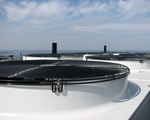Over the years as an acoustical consultant I’ve seen a lot of architectural firms locate rooftop air handling units over or near acoustically sensitive spaces; then they put up resistance to doing the necessary extensive noise controls that are needed for such a situation. The protest usually includes “but we’ve never had to do that in the past…” I call this rooftop roulette, because while not incorporating noise control design may have worked in the past, it does not guarantee future success.
Rooftop unit noise issues are typically very expensive to correct when they are discovered after the fact. Isn’t it worth a little insurance to not produce a problem in the first place?
Each situation is unique and the amount of potential noise issues depend on the support structure, the roof type, the vibration isolation, the mechanical and electrical noise producers in the unit, the duct layout and gauge, and the type of space that the unit sits over or near. Typical noise control methods may include stiffening the structure, vibration isolation curbs, sound blocking and absorbing assemblies inside the roof curb, running ducts over the roof for a distance, sound attenuators in the supply and return, acoustically lined discharge plenums, concrete or roof board around the unit, duct lagging, vibration isolation hangers for ductwork and piping, proper sealing of all roof penetrations, and reasonable air velocities and duct routing to minimize turbulence. If the designer considers these potential pitfalls in the design stage, then the game of roulette need not be played.
Acoustics By Design works with architects, engineers, and building owners to ensure that noise and vibration from rooftop air handlers can be controlled at the source. We use noise and vibration measurements and 3D computer modeling to analyze and/or to predict the cause of the problem, and we design solvent solutions to complex acoustical challenges before construction begins. Rooftop roulette can be an expensive game to play when your luck runs out. Is it really worth gambling on the design of your next facility?

We see a lot of rubber being used on roof top, I guess the awareness level is quite low. Buildings are getting sophisticated, the old conventional methods will have to be dropped, to stay in the race.
Rubber pads at roof tops are not very effective, with just 3-5 mm compression, they hardly do any isolation. Moreover, when they get hard due to ageing, there is a good chance that isolated equipment might get in to resonance with the isolator.